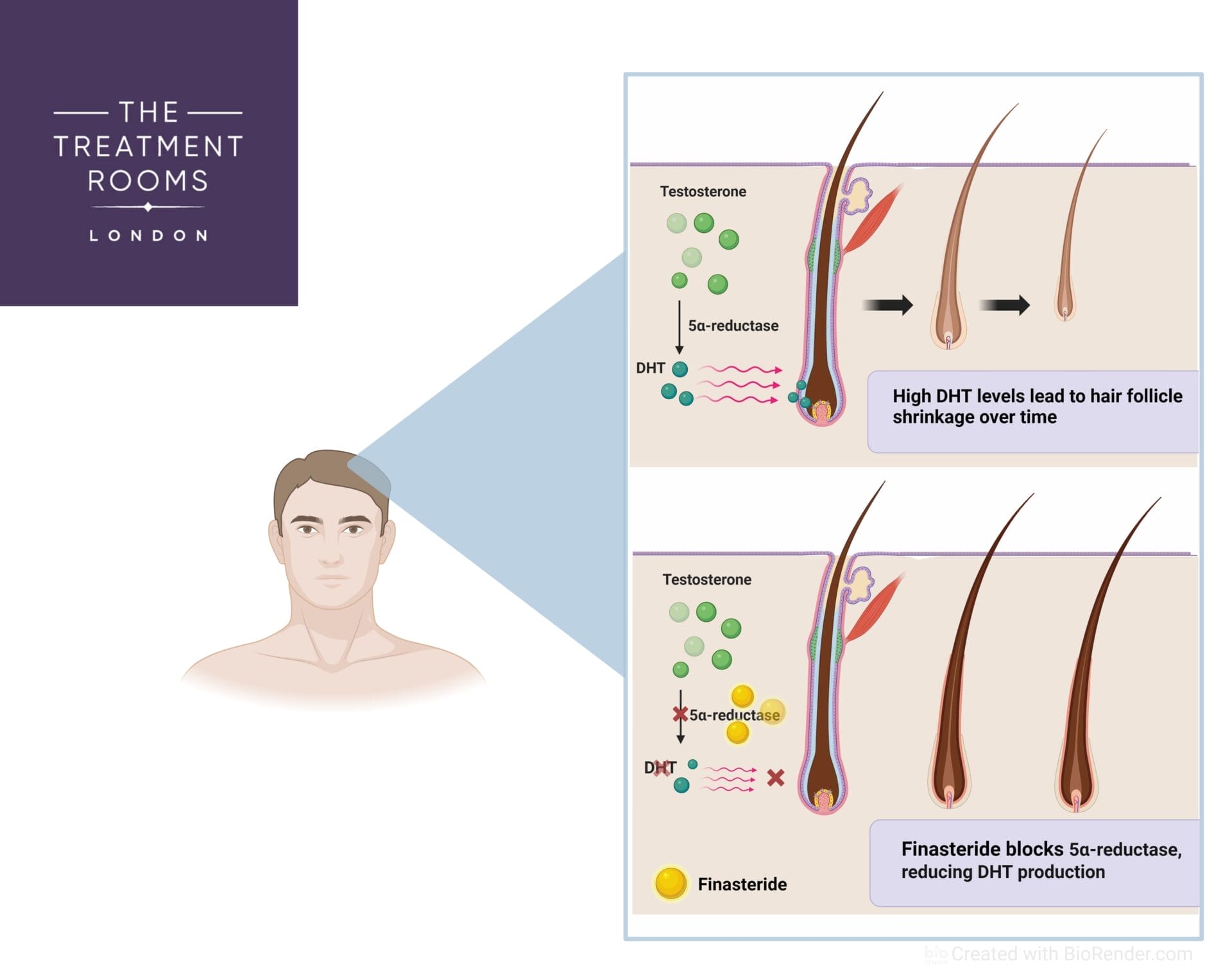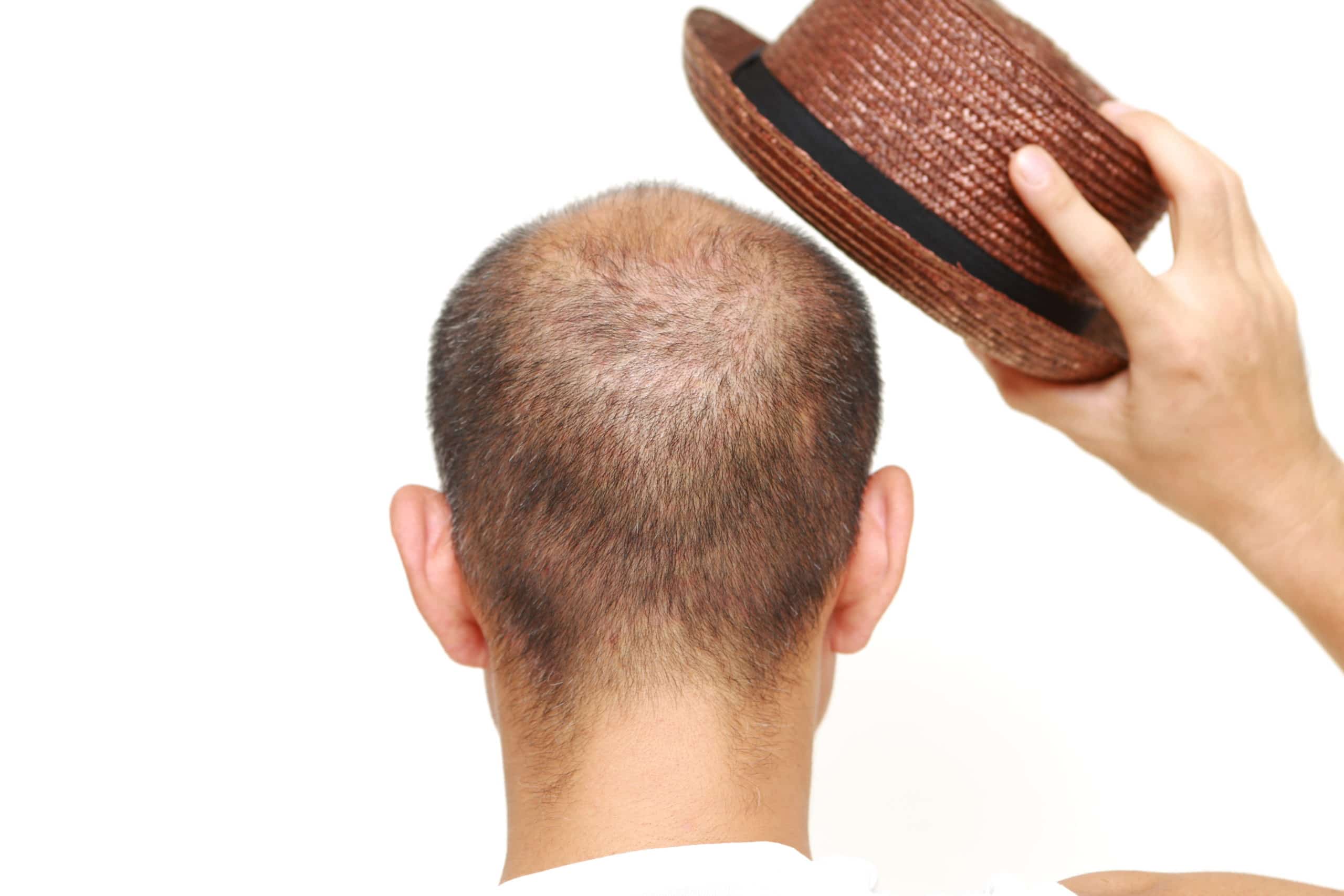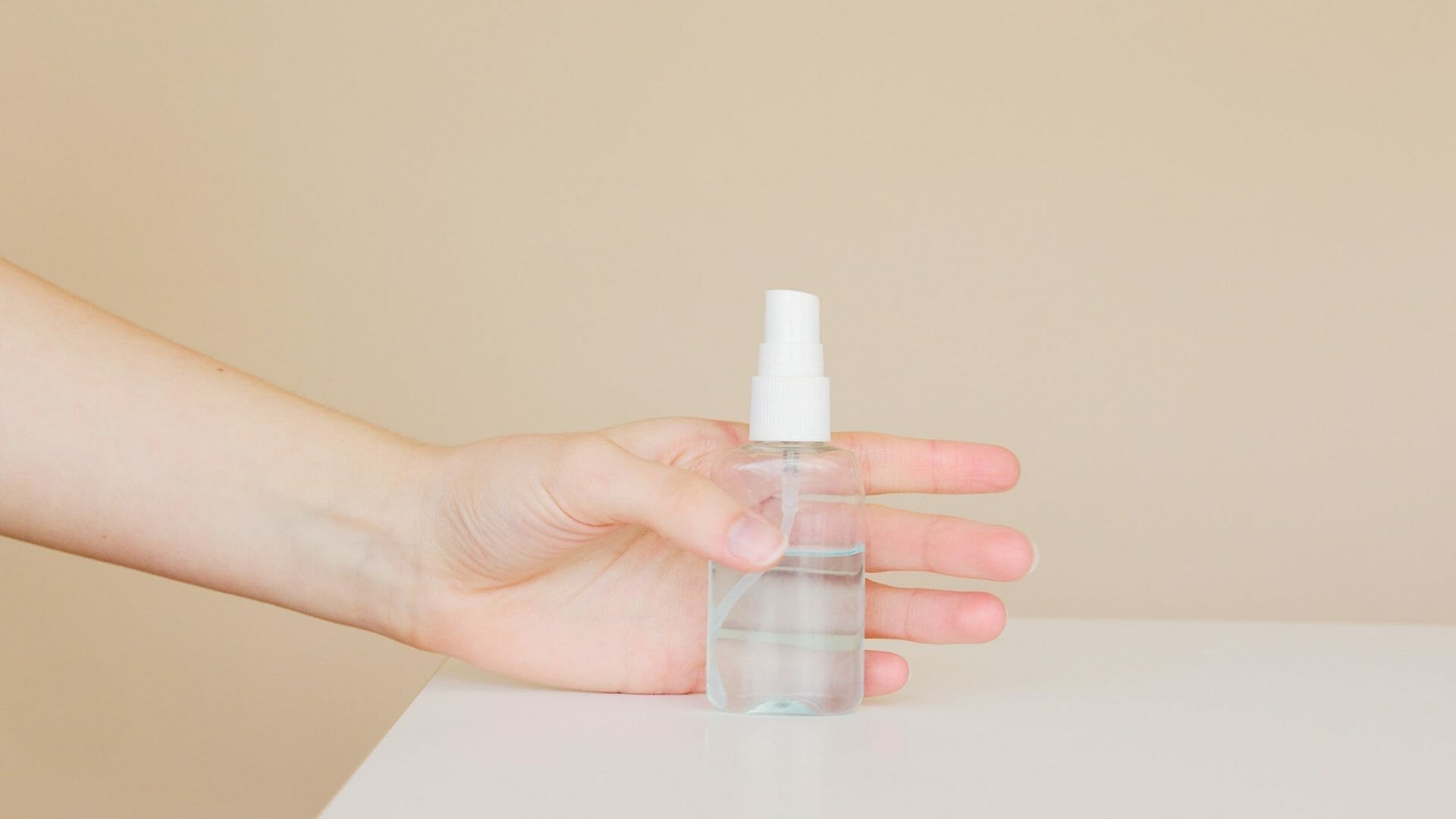Hair loss is a common concern that millions, if not billions, of people experience at some point in their lives. Although there are numerous forms of hair loss, the most commonly diagnosed type in men is ‘androgenetic alopecia’ or ‘male pattern balding’.
According to studies, this condition affects up to 50% of men by the age of 50 and is caused by dihydrotestosterone (DHT), a sex hormone present in both men and women.
This potent hormone can influence the health of hair follicles, especially in individuals who are genetically predisposed to male pattern hair loss.
In this article, we will dig deeper into the actions of DHT on hair and what you can do to prevent hair loss caused by this hormone.
Everything You Need to Know about DHT
DHT (dihydrotestosterone) is a sex hormone derived from testosterone. Testosterone gets converted into DHT by the enzyme 5-alpha reductase. In reality, only about 10% of circulating testosterone is converted to DHT. However, the effect of DHT remains potent, as it affects specific body parts, such as hair follicles, and plays a key role in development before birth and during puberty.
DHT has a range of physiological effects:
- Pubertal Development: DHT is indispensable for the formation of male genitalia and for deepening the voice during adolescence.
- Body Hair Growth: DHT encourages body and facial hair growth. Interestingly, despite encouraging growth elsewhere, it causes hair loss in the scalps of men with a genetic predisposition to male pattern baldness.
This table summarises some key statistics about hair loss in the UK:
| Category | Statistics |
| Men with pattern hair loss | Approximately 6.5 million men in the UK are affected by male pattern hair loss at some point in their lives. |
| Women with pattern hair loss | 8 million women in the UK experience female pattern hair loss. |
| Men with noticeable hair loss | Over 50% of men with hair loss have visible thinning or baldness by their early 50s5. |
| Women post-menopause with thinning hair. | After menopause, up to 50% of women may experience noticeable thinning after menopause6. |
DHT’s Relationship to Hair Follicles
Individuals with male pattern hair loss have fair follicles that are oversensitive to DHT and become damaged by the hormone. In these cases, DHT triggers a process called “miniaturisation,” where follicles gradually shrink over consecutive hair cycles until eventually they stop growing back.

Here’s what happens to the hair growth cycle:
- Shortened Anagen Phase: This phase typically lasts 2-6 years on average and can be shortened when exposed to DHT, which prevents the hair shaft from achieving its healthy length.
- Thinner Hair Shafts: Over time, these shortened growth phases produce progressively thinner strands that aren’t achieving full thickness.
- Increased Shedding: Eventually, miniaturised follicles thin until negligible hair is produced, which gives the appearance of thinned hair and eventual baldness.
Not every follicle on the scalp reacts this way. As a general rule of thumb, the hair follicles on the back and sides of the scalp are more resistant to damage by DHT and tend to stay thick and full. This explains why hair transplants use donor hair from these resilient regions.
This table lets us see how DHT relates to testosterone and hair loss:
| Measure | Effects of DHT |
| Conversion of testosterone to DHT | 10% of total testosterone. |
| Affinity compared to testosterone | DHT is up to 2- 10x more potent when bound to androgen receptors that activate male characteristics. |
| Linked to prostate enlargement | A significant number of men over the age of 50 may experience benign prostate hypertrophy (BPH) associated with DHT. |
| Role in scalp hair miniaturisation | A significant factor in androgenetic alopecia (pattern hair loss). |
Positive Effects of DHT
Many people view DHT as a villain when it comes to hair loss. However, this hormone still has some positive effects, including:
- Supports male genital development during foetal and pubertal stages4.
- Aids sexual health and libido as it binds to androgen receptors in specific tissues4.
- Regulates certain metabolic pathways in the body.
- It is thought to aid in maintaining healthy body composition and promoting muscle growth.
Adverse Effects of Elevated DHT
Now, let’s look at the adverse effects of elevated DHT levels:
- Scalp hair miniaturisation (due to androgenetic alopecia), which we already covered above.
- Increases the risk of Benign prostatic hyperplasia (BPH), or prostate enlargement.
- Excess DHT in females can lead to excessive body or facial hair growth.
- DHT can contribute to acne as it increases sebaceous gland activity11.
Medications That Lower DHT
Certain medications can help lower DHT levels in the body, which effectively helps slow and stabilise hair loss caused by androgenetic alopecia.
Finasteride
This drug can be found as a tablet or topical solution, and works to inhibit the conversion of testosterone to DHT by blocking the 5-alpha-reductase enzyme. Finasteride can slow hair loss in men, with the potential for partial regrowth in some individuals.

To maintain its benefits and prevent hair loss from resuming, Finasteride must be taken regularly to continue its effects and slow hair loss.
Dutasteride
Dutasteride works similarly to finasteride; however, it is more potent due to its ability to block two types of 5-alpha reductase enzymes (Type I and Type II). This drug is mainly used in individuals resistant to finasteride or no longer experiencing lasting benefits from it.
Minoxidil
Minoxidil is available as a tablet or topical solution and works to prolong the anagen phase, thereby improving blood flow and follicle health. This drug can be used safely in both men and women, with the topical form more commonly applied.
Lifestyle and DHT
Although medications and topical solutions are considered first-line treatments, lifestyle measures can still influence DHT levels and hair health:
Diet
A balanced intake of proteins, omega-3 fatty acids, vitamins, and minerals all helps support the function of hair follicles. Some data suggests that a high-sugar diet may worsen androgen imbalances15.
Exercise
Frequent physical activity modulates hormonal health. But remember, moderation is key! There is growing evidence that highly intense exercise may elevate certain hormones in ways that could impact hair growth.
Stress Management
Chronic stress elevates cortisol, a hormone produced by the adrenal glands. High cortisol levels can disrupt the body’s processing of DHT, potentially exacerbating hair loss as a result.

To tackle hair loss most effectively, we recommend combining healthy lifestyle measures with evidence-based treatments for optimal results.
DHT & Its Role in Hair Loss FAQs
- Does high testosterone automatically mean elevated DHT?
Not necessarily. High testosterone does not always mean high DHT. The conversion rate of testosterone to DHT depends on 5-alpha reductase activity and genetic factors. Therefore, two individuals with similar testosterone levels can have significantly different DHT levels.
- Why does DHT stimulate beard growth but reduce scalp hair?
The difference lies in how sensitive hair follicles are to DHT damage in some areas of the body. Facial hair follicles thrive under high DHT levels. On the other hand, scalp follicles in the frontal hairline, midscalp, and crown do not miniaturise when exposed to high DHT levels.
- Are there natural ways to lower DHT levels?
Some organic substances, such as saw palmetto, green tea extract, and rosemary oil, are believed to block DHT mildly. However, the results are still inconclusive. Additional natural ways to reduce hair loss include maintaining a healthy weight, limiting sugar intake, and managing stress to support balanced hormone levels.
- How long does it take to see improvements with DHT-blocking medications?
In general, 3–6 months of consistent use with Finasteride or Dutasteride is required to notice a slowdown in hair loss. Regrowth may appear after 6–12 months.
- Could DHT blockers affect libido or sexual function?
A small percentage of individuals who take finasteride/dutasteride report diminished libido or erectile difficulty. These side effects can be managed by reducing the medication dose, decreasing the frequency of administration (e.g., from daily to 2-3 times per week), or stopping the medication entirely.
Conclusion
DHT is a potent sex hormone that significantly contributes to male and female pattern hair loss in individuals with a genetic predisposition. This hormone shrinks scalp follicles and abnormally accelerates the hair cycle, leading to weaker, smaller hair follicles and eventual hair loss.
However, the good news is that modern medicine provides multiple avenues for treatment. Some of these options include 5-alpha reductase inhibitors (e.g., finasteride/dutasteride), topical agents (e.g., minoxidil), and more permanent solutions, such as hair restoration surgery.
If you suspect that DHT-related hair loss is affecting you, the first step is to consult with a qualified healthcare professional to determine the exact cause of your thinning tresses.
They will be able to conduct the necessary evaluations, recommend tailored treatments, and advise on supportive measures, ranging from lifestyle changes to medication use to surgical solutions. Embracing a well-rounded approach often yields the best outcomes in preserving, or even restoring, your luscious locks.
Get in touch
Ready to elevate your hair restoration journey? Book a free consultation call with our London-based FUE hair transplant clinic. If you are based in Brighton, you can reach out to our FUE hair transplant clinic in Brighton; we also offer consultations for Oxford and Bristol.
References
- https://emedicine.medscape.com/article/1070167
- Kinter KJ, Amraei R, Anekar AA. Biochemistry, Dihydrotestosterone. [Updated 2023 Jul 30]. In: StatPearls [Internet]. Treasure Island (FL): StatPearls Publishing; 2025 Jan-. Available from: https://www.ncbi.nlm.nih.gov/books/NBK557634/
- Handelsman DJ. Androgen Physiology, Pharmacology, Use and Misuse. [Updated 2020 Oct 5]. In: Feingold KR, Ahmed SF, Anawalt B, et al., editors. Endotext [Internet]. South Dartmouth (MA): MDText.com, Inc.; 2000-. Available from: https://www.ncbi.nlm.nih.gov/books/NBK279000/
- Okeigwe, I., & Kuohung, W. (2014). 5-Alpha reductase deficiency: a 40-year retrospective review. Current opinion in endocrinology, diabetes and obesity, 21(6), 483-487.
- Asfour L, Cranwell W, Sinclair R. Male Androgenetic Alopecia. [Updated 2023 Jan 25]. In: Feingold KR, Ahmed SF, Anawalt B, et al., editors. Endotext [Internet]. South Dartmouth (MA): MDText.com, Inc.; 2000-. Available from: https://www.ncbi.nlm.nih.gov/books/NBK278957/
- Chaikittisilpa, S., Rattanasirisin, N., Panchaprateep, R., Orprayoon, N., Phutrakul, P., Suwan, A., & Jaisamrarn, U. (2022). Prevalence of female pattern hair loss in postmenopausal women: A cross-sectional study. Menopause, 29(4), 415-420.
- English Jr, R. S. (2018). A hypothetical pathogenesis model for androgenic alopecia: Clarifying the dihydrotestosterone paradox and rate-limiting recovery factors. Medical hypotheses, 111, 73-81.
- Rosenberg, E. A., Bůžková, P., Fink, H. A., Robbins, J. A., Shores, M. M., Matsumoto, A. M., & Mukamal, K. J. (2021). Testosterone, dihydrotestosterone, bone density, and hip fracture risk among older men: The Cardiovascular Health Study. Metabolism: clinical and experimental, 114, 154399. https://doi.org/10.1016/j.metabol.2020.154399
- Hamdi, M. M., & Mutungi, G. (2011). Dihydrotestosterone stimulates amino acid uptake and the expression of LAT2 in mouse skeletal muscle fibres through an ERK1/2-dependent mechanism. The Journal of physiology, 589(Pt 14), 3623–3640. https://doi.org/10.1113/jphysiol.2011.207175
- Tong, Y., & Zhou, R. Y. (2020). Review of the Roles and Interaction of Androgen and Inflammation in Benign Prostatic Hyperplasia. Mediators of inflammation, 2020, 7958316. https://doi.org/10.1155/2020/7958316
- Sutaria AH, Masood S, Saleh HM, et al. Acne Vulgaris. [Updated 2023 Aug 17]. In: StatPearls [Internet]. Treasure Island (FL): StatPearls Publishing; 2025 Jan-. Available from: https://www.ncbi.nlm.nih.gov/books/NBK459173/
- Zito PM, Bistas KG, Patel P, et al. Finasteride. [Updated 2024 Feb 28]. In: StatPearls [Internet]. Treasure Island (FL): StatPearls Publishing; 2025 Jan-. Available from: https://www.ncbi.nlm.nih.gov/books/NBK513329/
- Al-Horani RA, Patel P. Dutasteride. [Updated 2024 Mar 20]. In: StatPearls [Internet]. Treasure Island (FL): StatPearls Publishing; 2025 Jan-. Available from: https://www.ncbi.nlm.nih.gov/books/NBK603726/
- Suchonwanit, P., Thammarucha, S., & Leerunyakul, K. (2019). Minoxidil and its use in hair disorders: a review. Drug design, development and therapy, 13, 2777–2786. https://doi.org/10.2147/DDDT.S214907
- Volk, K. M., Pogrebna, V. V., Roberts, J. A., Zachry, J. E., Blythe, S. N., & Toporikova, N. (2017). High-Fat, High-Sugar Diet Disrupts the Preovulatory Hormone Surge and Induces Cystic Ovaries in Cycling Female Rats. Journal of the Endocrine Society, 1(12), 1488–1505. https://doi.org/10.1210/js.2017-00305
Share:
Authored by
Reviewed by
Book a Consultation
Related Blogs
Can Black Seed Oil Help Hair Growth?
November 26, 2025
Quick Summary: Black Seed Oil & Hair Growth Black Seed Oil for Hair: Emerging as a key…
Do Hats Cause Hair Loss? Debunking Myths & Understanding the Facts
November 26, 2025
Hats have been a global trend to wear, whether for style, warmth, or sun protection. But have…
What Happens If You Stop Using Minoxidil
November 2, 2025
If you’ve been consistently applying minoxidil to support your hair growth, have you ever wondered what happens…
Unlocking the Secrets of Anagen Follicles
October 23, 2025
Have you ever glanced at a mirror and wondered why some of your hair grows fast and…
Does Finasteride Cause Erectile Dysfunction?
October 22, 2025
Finasteride is one of the most promising medicines against male pattern baldness and benign prostatic hyperplasia (BPH)….
Zinc Supplements After Hair Transplant Surgery: What You Need to Know
October 7, 2025
Zinc is an essential nutrient in wound healing, tissue repair, and the healthy development of hair follicles….
What to Eat After a Hair Transplant: Essential Nutritional Guide
October 5, 2025
After the stress, needles, and surgeries, food becomes more than nourishment. A warm bite, a familiar flavour,…
Hair Loss Treatment That Works: A Complete Guide for 2025
October 3, 2025
Millions of men, women, and teenagers have hair loss problems. In 2025, hair restoration is going through…
What is an FUE Hair Transplant?: A Comprehensive Guide to Procedure, Recovery, and Results
October 3, 2025
Hair transplant surgery has gained popularity over the years, with more people now comfortable taking care of…










